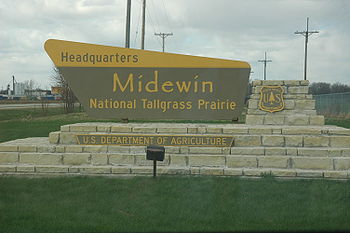
Midewin National Tallgrass Prairie
Encyclopedia
41.34252°N 88.13123°W
 The Midewin National Tallgrass Prairie is a prairie
The Midewin National Tallgrass Prairie is a prairie
reserve operated by the United States Forest Service
. It is in the Central forest-grasslands transition
ecoregion
. It is located on the site of the former Joliet Army Ammunition Plant
near Elwood, Illinois
, and was established by federal law in 1996. The Illinois Land Conservation Act (Public Law 104-106) created the Midewin National Tallgrass Prairie, designated the transfer of 19165 acres (78 km²) of land in Illinois from the U.S. Army to the U.S. Department of Agriculture's Forest Service, and mandates that Midewin be managed to meet four primary objectives:
The first land transfer from the Army to the Forest Service took place on March 10, 1997, and included 15080 acres (61 km²) of land that was believed to be free from contamination. Subsequent land acquisitions place the current size of Midewin at 15454 acres (63 km²). After a period of ecological restoration, part of the prairie opened to visitors in 2004. Another section remains closed to visitors because of toxic waste
contamination.
MNTP is the only federally managed tallgrass prairie
located east of the Mississippi River
where surviving areas of that biome are extremely rare.

Prairie
Prairies are considered part of the temperate grasslands, savannas, and shrublands biome by ecologists, based on similar temperate climates, moderate rainfall, and grasses, herbs, and shrubs, rather than trees, as the dominant vegetation type...
reserve operated by the United States Forest Service
United States Forest Service
The United States Forest Service is an agency of the United States Department of Agriculture that administers the nation's 155 national forests and 20 national grasslands, which encompass...
. It is in the Central forest-grasslands transition
Central forest-grasslands transition
The Central forest-grasslands transition are a prairie ecoregion of the central United States, part of the North American Great Plains.-Setting:...
ecoregion
Ecoregion
An ecoregion , sometimes called a bioregion, is an ecologically and geographically defined area that is smaller than an ecozone and larger than an ecosystem. Ecoregions cover relatively large areas of land or water, and contain characteristic, geographically distinct assemblages of natural...
. It is located on the site of the former Joliet Army Ammunition Plant
Joliet Army Ammunition Plant
Joliet Army Ammunition Plant formerly known as the Joliet Arsenal was a United States Army arsenal located in Will County, Illinois, near Elwood, Illinois, south of Joliet, Illinois. Opened in 1940 during World War II, the facility consisted of the Elwood Ordnance Plant and the Kankakee Ordnance...
near Elwood, Illinois
Elwood, Illinois
Elwood is a village in Will County, Illinois, United States. The population was 2,300 at the 2006 population estimation.-Geography:Elwood is located at . The nearest major highways are Interstate 80 to the north and Interstate 55 to the west. The former Route 66 highway passes through the...
, and was established by federal law in 1996. The Illinois Land Conservation Act (Public Law 104-106) created the Midewin National Tallgrass Prairie, designated the transfer of 19165 acres (78 km²) of land in Illinois from the U.S. Army to the U.S. Department of Agriculture's Forest Service, and mandates that Midewin be managed to meet four primary objectives:
- 1) To conserve, restore, and enhance the native populations and habitats of fish, wildlife, and plants.
- 2) To provide opportunities for scientific, environmental, and land use education and research.
- 3) To allow the continuation of existing agricultural uses of lands within Midewin National Tallgrass Prairie for the next 20 years, or for compatible resource management uses thereafter.
- 4) To provide recreational opportunities that are compatible with the above purposes.
The first land transfer from the Army to the Forest Service took place on March 10, 1997, and included 15080 acres (61 km²) of land that was believed to be free from contamination. Subsequent land acquisitions place the current size of Midewin at 15454 acres (63 km²). After a period of ecological restoration, part of the prairie opened to visitors in 2004. Another section remains closed to visitors because of toxic waste
Toxic waste
Toxic waste is waste material that can cause death or injury to living creatures. It spreads quite easily and can contaminate lakes and rivers. The term is often used interchangeably with “hazardous waste”, or discarded material that can pose a long-term risk to health or environment.Toxic waste...
contamination.
MNTP is the only federally managed tallgrass prairie
Tallgrass prairie
The tallgrass prairie is an ecosystem native to central North America, with fire as its primary periodic disturbance. In the past, tallgrass prairies covered a large portion of the American Midwest, just east of the Great Plains, and portions of the Canadian Prairies. They flourished in areas with...
located east of the Mississippi River
Mississippi River
The Mississippi River is the largest river system in North America. Flowing entirely in the United States, this river rises in western Minnesota and meanders slowly southwards for to the Mississippi River Delta at the Gulf of Mexico. With its many tributaries, the Mississippi's watershed drains...
where surviving areas of that biome are extremely rare.

